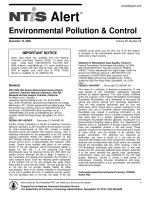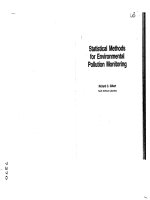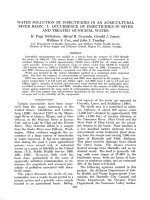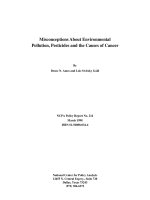Topic environmental pollution by transport
Bạn đang xem bản rút gọn của tài liệu. Xem và tải ngay bản đầy đủ của tài liệu tại đây (3.24 MB, 25 trang )
<span class="text_page_counter">Trang 1</span><div class="page_container" data-page="1">
BỘ GIÁO DỤC VÀ ĐÀO TẠO
<b>TRƯỜNG ĐẠI HỌC THƯƠNG MẠI</b>
<b>---BÀI THẢO LUẬNMÔN: TIẾNG ANH 1</b>
<b>TOPIC: ENVIRONMENTAL POLLUTION BY</b>
</div><span class="text_page_counter">Trang 2</span><div class="page_container" data-page="2"><b>1.2. Definition of types of pollution...7</b>
<i><b>CHAPTER 2.INFLUENCES OF ENVIRONMENTAL POLLUTION BY </b></i>
<b>3.1. Use of clean fuels for vehicles...23</b>
3.1.1. Using LPG - a source of clean raw materials...23
3.1.2. Use of biofuels...24
</div><span class="text_page_counter">Trang 3</span><div class="page_container" data-page="3">3.1.3. Use electricity for vehicles instead of gasoline...24
<b>3.2. Increase the use of public transport...25</b>
<b>3.3. Encourage people to use bicycles or walk...25</b>
<b>3.4. Develop policies, improve vehicle emission control...26</b>
3.4.1. Low Emission Zones (LEZs)...26 3.4.2. Control and recall of used cars and subsidize new cars with less fuel consumption 27
</div><span class="text_page_counter">Trang 4</span><div class="page_container" data-page="4"><b>MEETING MINUTES (1) - GROUP 5</b>
<b>Meeting format: online </b>
<b>1. Head of the team: Hoàng Đức Thịnh 2. Members:</b>
Phạm Thị Sen Bùi Thị Phương Thảo Đào Thị Thanh Thảo Nguyễn Phương Thảo Hoàng Đức Thịnh Vũ Thị Mai Thoa
<b>3. Time</b>
The meeting begins at 21:30 on February 2, 2024, and ends at 22:30 on February 2, 2024.
<b>4. Contents for discussing:</b>
Reason for choosing Chapter 1: Introduction
Chapter 2: - The current situation of environmental pollution caused by transport; - Cause of environmental pollution from transport;
- Effects of environmental pollution by transport. Chapter 3: Solutions
Recorder Phạm Thị Sen
</div><span class="text_page_counter">Trang 5</span><div class="page_container" data-page="5">The discussion of English 01 of group 05 with the topic "Evironmental pollution by transport" is the result of the dedicated guidance of the lecturer and the relentless efforts, solidarity and support of the group 05.
Through this, our group of 05 would like to express our sincere thanks to lecturer Nguyen Thi Thuy Hanh for guiding, communicating as well as providing materials so that we can successfully complete our discussion.
<b>Nhóm 05 – Đại học Thương mại</b>
</div><span class="text_page_counter">Trang 6</span><div class="page_container" data-page="6"><b>REASON FOR CHOOSING THE TOPIC</b>
Environmental pollution is becoming one of the biggest and most urgent problems globally. Among the many causes of infectious pollution, traffic plays an important and especially notable role. Associate Professor, Dr. Nguyen Van Son - Institute of Occupational Health and Environment also said that transportation is the leading cause of increased air virus pollution in urban areas, contributing 70% of the total amount of dust and gas. emitted into the atmosphere.
Economic and population growth is leading to a large amount of utility traffic in major cities. This creates a significant pressure on the environment, as the amount of emissions and other pollutants from these utility vehicles increases significantly. In Vietnam, PM2.5 concentration in Hanoi is currently 21.9 times higher than the value according to WHO's annual air quality guidelines. No PM2.5 PM2.5 at City. Ho Chi Minh City is currently 16.4 times higher than the value according to WHO's annual air quality guidelines. This urban area is facing the problem of toxic air quality, directly affecting public health. Not only is there dust and smoke, but it also contains toxic substances from mechanical exhaust, all of which contribute to environmental pollution. Therefore, the decision to choose the research topic "Environmental pollution as traffic" is not only a concern for environmental issues but also an awareness of the importance of the impact of public transport vehicles. Community health and the ecosystem is also an opportunity to offer practical solutions, contributing to building a healthy and solid living environment for future generations.
6
</div><span class="text_page_counter">Trang 7</span><div class="page_container" data-page="7"><b>CHAPTER 1.INTRODUCTION</b>
<b>1.1. General concept</b>
<b>1.1.1. The concept of pollution </b>
Pollution is the destruction of the environment by dirt and harmful waste. Pollution comes in many forms such as smoke from factory chimneys, emissions from vehicles, toxic chemicals, etc. It is often called external influence when studying the industrial production research process. and is considered a price to pay for growth.
<b>Types of pollution:</b>
All types listed below were created by three main human development activities: industrialization, urbanization and mechanization. So, their control is almost impossible in the current way of life and development but we can minimize it to a limit at which we can survive or feel comfortable. Thus, environmental pollution can be classified on an average basis. That is:
According to the Law on Environmental Protection of the Socialist Republic of Vietnam (1994), "The environment includes natural elements and artificial material elements that are closely related to each other surrounding humans, having affects the life, production, existence and development of humans and nature".
For humans, the human living environment is the combination of physical, chemical, biological, and social conditions that surround and affect the life and development of each individual and human community. The term "Environment" is often commonly used as the "Environmental" issue of the times, a country's "environmental" strategy, "environmental" degradation, etc., which implies the living environment of a country. human.
</div><span class="text_page_counter">Trang 8</span><div class="page_container" data-page="8">Human living environment is the vast universe. Including the solar system, the Earth system is the part that directly and most clearly affects human life.
<b>1.1.3. Concept of enviromental pollution</b>
Environmental pollution is a phenomenon in which the natural environment is polluted by introducing polluting chemicals into the natural environment, and at the same time the physical, chemical and biological properties of the environment are changed, causing harmful effects. to human health and other organisms.
The World Health Organization (WHO) defines environmental pollution as the transfer of wastes or materials into the environment to levels that are likely to harm human health and biological development or reduce their quality habitat.
<b>1.1.4. Vehicle concept</b>
Mean of transportation are vehicles that move and travel publicly on roads. Road vehicles include all vehicles such as cars, motorbikes, tractors, trailers, and semi-trailers. pulled by cars, tractors, etc. Two-wheeled, three-wheeled motorbikes, mopeds including electric motorbikes and other similar vehicles.
<b>1.2. Definition of types of pollution</b>
<b> Air pollution caused by transportation vehicles is typically the emission of</b>
pollutants such as carbon monoxide (CO), nitrogen oxides (NOx), particulate matter (PM), and volatile organic compounds (VOCs) from vehicles' exhausts. These pollutants can have detrimental effects on both human health and the environment.
<b> Traffic noise pollution refers to the excessive or unwanted sound generated byvehicles, including cars, trucks, motorcycles, buses, and trains, as they move through the</b>
transportation network. This noise can disrupt communities, affect human health, and degrade the environment.
<b>Light pollution from transportation vehicles refers to the excessive or</b>
unnecessary illumination produced by headlights, streetlights, and other lighting systems on vehicles. This type of pollution can disrupt ecosystems, affect wildlife behavior, and interfere with astronomical observations.
8
</div><span class="text_page_counter">Trang 9</span><div class="page_container" data-page="9"><b>CHAPTER 2.INFLUENCES OF ENVIRONMENTALPOLLUTION BY TRANSPORT</b>
<b>2.1. The current situation of environmental pollution caused bytransport</b>
<b>2.1.1. In the world</b>
The problem of environmental pollution caused by vehicles is becoming increasingly serious, contributing significantly to global pollution. The constant increase in the number of vehicles on the road, coupled with the rapid development of the vehicle industry, has posed major environmental challenges.
SPECIFIC DATA THAT TRANSPORT VEHICLES GIVE OUT
The following table compares the emissions of different means of transport for passenger transport in Europe:
<small>Total GHG from transport in the European Union</small>
The following table compares the emissions of different means of transport in passenger transport in Europe:
</div><span class="text_page_counter">Trang 10</span><div class="page_container" data-page="10">Aviation emissions vary depending on the length of the flight. To cover long distances, longer flights are a better investment given the high energy costs of takeoff and landing than very short flights, however due to the nature of their length inevitably will use more energy. CO2 emissions from air travel range from 0.24 kg CO2 per passenger mile (0.15 kg/km per passenger) for short flights to 0.18 kg CO2 on per passenger mile (0.11 kg/km per passenger) for long flights.
Researchers are raising concerns about the increasing mobility of society globally, associated with frequent and frequent air travel and its environmental and climate impacts. This threatens to undo gains in aircraft efficiency and their operations. Climate scientist Kevin Anderson raised concerns about the growing impact of air transport on climate in an article and a presentation in 2008. He pointed out that even if annual growth rate of air passengers in the UK and with the government's target of reducing emissions in other energy-using sectors, by 2030 aviation will cause 70% of allowable CO2 emissions of the United Kingdom.
Worse still, aircraft emissions at stratospheric altitudes have a larger contribution to radiative forcing than emissions at sea level, due to the influence of several greenhouse gases in the emissions, in addition to CO2. Other greenhouse gases include methane (CH4), ozone-producing NOx [O3], and water vapor. Overall, in 2005, the radiation forcing caused by aviation amounted to 4.9% of the total anthropogenic radiation forcing on the Earth's heat balance.
- Car
The proportion of trucks produced in the United States has tripled since 1975. Although vehicle fuel efficiency has increased in each class, the overall trend toward less efficient vehicles is offset some of the benefits of better fuel economy and reduced pollution and carbon dioxide emissions. Without switching to SUVs, energy use per unit of distance could decrease by more than 30% compared to the period 2010 to 2022. When burned, unleaded gasoline produces 8.91 kg of CO2 per gallon, while diesel produces 10.15 kg Ethanol-derived CO2 emissions are ignored by international 10
</div><span class="text_page_counter">Trang 11</span><div class="page_container" data-page="11">agreements, however, gasoline containing 10% ethanol would only be considered to produce 8.02 kg of CO 2 per gallon. The average fuel economy of new light vehicles sold in the US for the 2017 model year is about 24.9 MPG and emits about 0.36 kg of CO 2 per mile. The Department for Transport's MOBILE 6.2 model, used by regional authorities to model air quality, uses a fleet average (all cars, old and new) of 20.3 mpg generates about 0.44 kg CO 2 per mile.
In Europe, the European Commission has implemented a regulation that from 2015 all newly registered cars will not emit more than an average of 0.13 kg CO 2 per km (kg CO2/km). . The target is that by 2021, the average emissions of all new cars are 0.095 kg CO2 per km.
- Bus: On average, city buses emit 0.3 kg CO2 per passenger mile (0.18 kg/km per passenger) and long-distance buses (>20 miles, >32 km) emit 0. 08 kg CO2 per passenger mile (0.05 kg/km per passenger). Road and transport conditions vary, so some carbon calculations add 10% to the total distance of the trip to account for potential traffic jams, detours and stops that may arise born.
On average, passenger trains and subways emit 0.17 kg CO 2 per passenger mile (0.11 kg/km per passenger) and long-distance trains (>20 miles, >32 km) emit 0.19 kg of CO2 per passenger mile (0.12 kg/km per passenger). Some carbon calculations add 10% to the total trip distance to account for detours, stops and other issues that may arise. Electric trains contribute relatively less to pollution because pollution occurs in power plants that operate much more efficiently than diesel engines.
Pollution is another direct result of railways on the environment. Railways can pollute the environment due to what they carry. Railway pollution exists in all three states of matter: gas, liquid and solid. Air pollution can occur from cars carrying materials such as iron ore, coal, soil or aggregates and exposing these materials to the air. This can release nitrogen oxides, carbon monoxide, sulfur dioxide or hydrocarbons into the air. Liquid pollution can come from railways contributing to runoff into water supplies, such as groundwater or rivers, and can come from dumping fuels such as oil into water supplies or onto land or discharging human waste unhealthy way.
</div><span class="text_page_counter">Trang 12</span><div class="page_container" data-page="12">The road transport industry is contributing around 20% of the UK's total carbon emissions each year, with only the energy sector making a larger contribution, around 39%. Road transport is a significant consumer of fossil fuels and associated carbon emissions – HGV vehicles account for almost 20% of total emissions.
Emissions from ships have a much more significant environmental impact; Many ships travel internationally from port to port and are not seen for weeks, contributing to air and water pollution during their journey.
Discharges of wastewater into water bodies can come from many sources, including wastewater treatment facilities, wastewater from livestock operations, and vessels. These wastes have the potential to degrade water quality, adversely affect the aquatic environment and increase risks to human health. Environmentally, this causes species to go extinct and harms the environment and local businesses.
12
</div><span class="text_page_counter">Trang 13</span><div class="page_container" data-page="13"><b>2.1.2. In Vietnam.</b>
<b>CURRENT SITUATION OF AIR POLLUTION FROM TRAFFIC</b>
Vietnam is no exception and is also facing many impacts from environmental pollution caused by vehicles, similar to many countries around the world. Although Vietnam has unique features in its cultural and geographical context, air pollution, noise pollution and traffic congestion are also affecting the quality of life and health of the community copper. The increased use of personal vehicles, motorbikes and cars, along with the expansion of transport infrastructure, has largely contributed to this problem. Large urban areas such as Hanoi and Ho Chi Minh City are facing a sudden increase in vehicle traffic and increased pressure on environmental pollution. According to Associate Professor - Dr. Nguyen Van Son of the Institute of Occupational Health and Environment, emissions from vehicles are the leading cause of increased air pollution in urban areas, accounting for 70% of total dust. and emissions into the air environment. In addition, fine dust, soot, due to the process of transporting volatile chemicals, garbage and construction materials,... also contribute to increasing pollution.
Analytical results from many environmental impact assessment reports show that dust pollution occurs in most large cities in Vietnam. Even in some big cities like Hanoi City and Ho Chi Minh City, this situation has become more serious at an alarming rate. There are times when the average amount of dust in the air is 200 - 300 times higher than the allowed standard. Not to mention, the emission of many types of toxic emissions such as CO, CO2, NO2, black smoke,... from vehicles makes air pollution even more serious. In major urban areas like Hanoi has the second-worst air quality in Southeast Asia after Pasarkemis in Indonesia, according to a 2022 annual survey by IQAir, a Swiss air purifier manufacturer.
</div>








